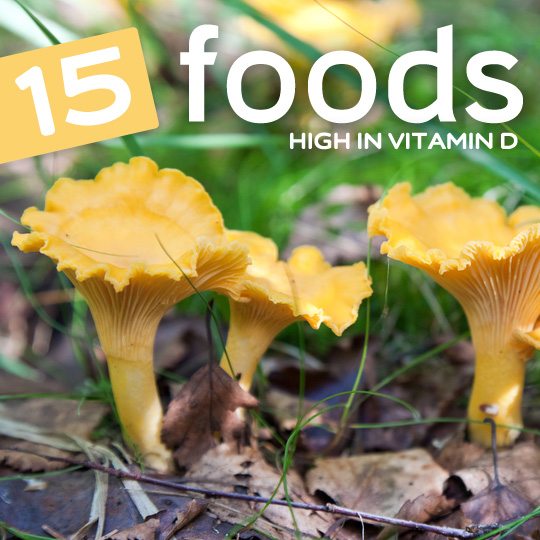Get familiar with this list of foods highest in Vitamin D so you know what your best options are for supplementing your diet. Vitamin D is an important vitamin to stay topped up on, and getting enough sunshine gets you started, but you’ll still want to make sure you’re rounding that off with a balanced diet rich in Vitamin D foods.
All of the foods listed below are not just wonders when it comes to Vitamin D, they also provide you with other essential nutrients your body needs each day. These include omega-3s, protein, iron, fiber, calcium and more. That’s why it’s good to eat a broad number of foods so you are getting a variety of everything you need. Always remember to help your body produce its own Vitamin D by exposing bare skin to the sun on a regular basis, not long enough to get burned. The body is able to store Vitamin D, so this doesn’t need to be done daily, but should be done regularly.
[hr]
[column size=”one-third”] [/column]
[/column]
[column size=”two-third” last=”true”]
1. Eel: 932 IU Vitamin D (233% DV)
Eel may not be a menu regular but it still one of the highest Vitamin D foods on the planet. Like most sea creatures it’s not just a good source of one vitamin, but a number of vitamins and minerals.
Eel contains both EPA and DHA forms of omega-3s, and therefore all of the benefits these provide, including being and to help with cholesterol levels, as well as anti-cancer benefits.
It’s also a good source of protein, and even though the image of a water snake might not conjure up the idea of deliciousness, it has a savory flavor when prepared correctly, and won’t have a rubbery texture to it, but will be soft and delectable.
Tips for eating more: Don’t fancy making your own eel at home? Go out for sushi and look for the unagi roll. That is sushi with a broiled eel on the top and a special sauce. It’s delicious and one of the few sushi pieces you’ll find that isn’t raw.[/column]
[hr]
[column size=”one-third”]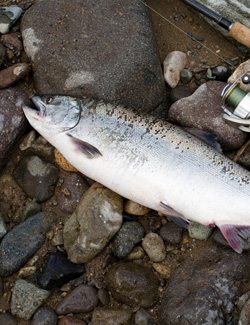 [/column]
[/column]
[column size=”two-third” last=”true”]
2. Salmon: 906 IU Vitamin D (227% DV)
Salmon provides nearly as much Vitamin D as eel, and is probably the one you’re more likely to eat on a regular basis. And you should, as salmon is often recommended as a fish you should be eating with regularity.
This is because salmon won’t just fill your Vitamin D reservoirs, it will give you a big boost in omega-3s, and is a very rich source of protein. That’s why it’s a favorite on many diet plans, because it provides protein for building lean muscle, or simply balancing out a meal, and because it can help tame inflammation by being anti-inflammatory food.
Salmon gets credited for being a good food to eat for heart health, and has even been linked to increased brain performance, both short term and for the long term, helping to reduce the risk of Alzheimers and other degenerative brain diseases.
Tips for eating more: Salmon is easy to prepare in a number of ways, baked in the over during the winter and placed on the grill during the summer. It can even be made into kebabs.[/column]
[hr]
[column size=”one-third”] [/column]
[/column]
[column size=”two-third” last=”true”]
3. Sardines: 480 IU Vitamin D (120% DV)
Sardines are known for their strong taste and aroma, but should really be known for their Vitamin D content. You don’t need to eat a full 100 gram serving of sardines to benefit from the Vitamin D they have, since even half of this serving will provide you with more than half of your daily value of Vitamin D.
Sardines are an example of an oily fish that is rich in omega-3 fatty acids and as such provides the many benefits associated with omega-3s.
Calcium, potassium, and iron round out the top 3 minerals that sardines provide in addition to the omega-3s and Vitamin D.
Tips for eating more: Sardines can be a tricky food to eat more of, since they have a strong flavor and small size. You can try adding them to a seafood chowder, or on a pizza. You can eat them as a snack as well, since they full of protein they’ll hold you over.[/column]
[hr]
[column size=”one-third”]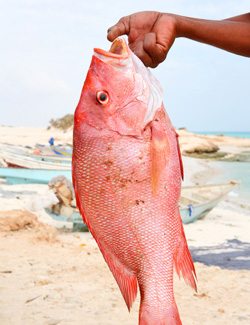 [/column]
[/column]
[column size=”two-third” last=”true”]
4. Snapper: 408 IU Vitamin D (102% DV)
Snapper is a fish that stands out among other as being a good source of Vitamin D, placing it in the top 5 of our countdown. A 100 gram serving of snapper gives you a full day’s supply of Vitamin D. As long as you are getting enough Vitamin A, it’s OK if you go over on your Vitamin D intake.
The selenium in snapper is one more reason to eat it. Selenium helps the body by getting the thyroid gland to a happy place. And since snapper is naturally low in calories and a rich source of protein, you’re helping yourself in a number of ways just with a serving of fish.
Snapper is just one example of fish that contains Vitamin D. You’ll do well with other types of fish, such as mackerel, flounder, and tilapia.
Tips for eating more: Snapper is a delicious fish that can be served up as your main entree and paired with a carb and a vegetable for a balanced meal.[/column]
[hr]
[column size=”one-third”]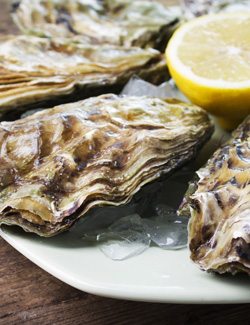 [/column]
[/column]
[column size=”two-third” last=”true”]
5. Oysters: 320 IU Vitamin D (80% DV)
Joining several ocean-based food on our list, oysters are an impressive source of Vitamin D, and can be used as part of a healthy diet as long as they are fried or covered with unhealthy ingredients.
Because of the omega-3s in oysters, they’re a good choice for heart health, as they’ll help decrease the chance of having a stroke or heart attack, and get your blood pressure numbers to a safer place.
Oysters are a solid source of protein, as well as iron and magnesium. They also give you a big dose of Vitamin B12, which may be one of the reasons why they’re often cited as an aphrodisiac.
Tips for eating more: Oysters may be viewed as a once-in-a-while food, or even just for a special occasion, but they can be worked into the regular menu more often, or added to a seafood chowder.[/column]
[hr]
[column size=”one-third”]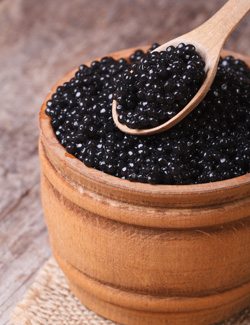 [/column]
[/column]
[column size=”two-third” last=”true”]
6. Caviar: 232 IU Vitamin D (58% DV)
Caviar makes the top 10 on our list of foods high in Vitamin D, and it is likely not a source that you eat each week. Caviar is often associated with Lifestyle of the Rich and Famous, with Robin Leach and his catchphrase of champagne wishes and caviar dreams.
But aside from its ritzy profile caviar can help with depression and a host of other diseases and conditions thanks to the omega-3s it contains.
If you want to become an expert at caviar, things can get expensive. The older the caviar get the more expensive it becomes because it ages like a fine wine. But for those that just want to eat it for its healthy benefits, younger caviar is still delicious and far less expensive.
Tips for eating more: Not just for the rich and famous, quality caviar can be found on the relative cheap these days, and their small size means you can put them on just about anything, or simply eat them directly on toast points like you see in the movies.[/column]
[hr]
[column size=”one-third”] [/column]
[/column]
[column size=”two-third” last=”true”]
7. Chanterelle Mushrooms: 212 IU Vitamin D (53% DV)
Chanterelle mushrooms impress with their levels of Vitamin D, and even just a small serving will net you a big piece of the daily Vitamin D puzzle.
It’s interesting to note the different types of mushrooms and that each type has its own strengths when it comes to certain vitamins and minerals. It’s a good idea to sample different mushrooms to see which ones you like best and then cross check which nutrients your favorite ones provide.
Chanterelle mushrooms have a distinct look and flavor to them, and they may not be available at every large grocery chain. They are worth finding due to the host of vitamins they provide.
Tips for eating more: Since many types of mushrooms provide you with Vitamin D, you can add them to pizzas and sandwiches, or saute them as a side dish. They also work great with main entrees, either placed on top or worked into a casserole or sauce.[/column]
[hr]
[column size=”one-third”] [/column]
[/column]
[column size=”two-third” last=”true”]
8. Herring: 167 IU Vitamin D (42% DV)
Herring weighs in with a healthy dose of Vitamin D, netting you almost half your daily requirement from a 100 gram serving.
The reason most people seek out herring is due to the omega-3s it contains, but if you’re looking to meet your Vitamin D needs you can consider the omega-3s a very nice side benefit. It’s always a bonus when a food provides high levels of more than one important nutrient.
You can go with fresh or canned herring to get these benefits, with canned herring being a convenient and quick on-the-go snack.
Tips for eating more: You can generally find pickled herring in the same place you’d find other canned fish. It may be labeled as “seafood snacks”, “kippered”, or “kippered snacks” but this is referring to herring that has been pickled and smoked and butterflied before being canned. It can be eaten directly without the need to cook or heat it.[/column]
[hr]
[column size=”one-third”]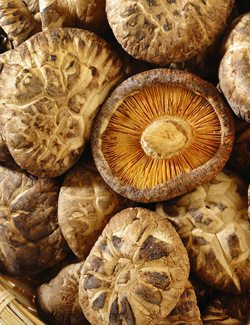 [/column]
[/column]
[column size=”two-third” last=”true”]
9. Shiitake Mushrooms: 154 IU Vitamin D (39% DV)
Shiitake mushrooms are one of the healthiest mushrooms you can eat, and their Vitamin D boost is just one reason why.
The big reason why shiitake mushrooms have enjoyed more notoriety in recent years is due to the boost to the immune system. But perhaps the next big push to eat these particular mushrooms will be because of the way they help the cardiovascular system, and what this means for your heart health.
So not only will you be helping your overall health and general wellbeing, you could directly be helping sustain a long and active life. Shiitake mushrooms can be discerned from other mushrooms by the pattern on their caps.
Tips for eating more: You’ll need to specifically seek out shiitake mushrooms, which will mostly likely be next to all of the other mushrooms, but not all stores will carry them. They’re getting more and more common though, making them easier to find.[/column]
[hr]
[column size=”one-third”]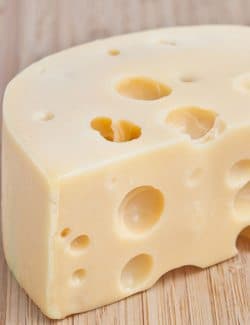 [/column]
[/column]
[column size=”two-third” last=”true”]
10. Cheese: 102 IU Vitamin D (26% DV)
While cheese gets the boot from most diet plans due to its high fat content, it is actually a good source of Vitamin D, calcium, and protein. So before writing it off, consider using it in moderation for these qualities.
Cheese is made from milk, and milk ads have long boasted that it’s a good source of Vitamin D and calcium. Because of the processing that cheese goes through it has more Vitamin D and calcium than milk, allowing it to rank above milk on our list.
If you’re considering adding more cheese to your diet, first check to see how well you process dairy products. Go on an elimination diet whereby you eliminate dairy for one month. Then try reintroducing it to see how well your body handles it.
Tips for eating more: Even though cheese is high in Vitamin D, it’s also high in fat, calories, and cholesterol, so you’ll want to balance your consumption of it to get the pros of the vitamins, calcium, and protein it contains, without the cons of its other contents.[/column]
[hr]
[column size=”one-third”] [/column]
[/column]
[column size=”two-third” last=”true”]
11. Tuna: 80 IU Vitamin D (20% DV)
Tuna is a popular fish choice, and can greatly increase the amount of Vitamin D you’re getting in just one serving. Since it’s readily available in cans and pouches, it also makes for one of the easiest ways to add more Vitamin D to your diet.
Tuna is a great source of lean protein as well as iron and omega-3s. Packaged tuna comes ready to eat, and can really come in handy when you’re in need of a snack to get you through to your next meal. A healthy tuna salad can be made with sugar-free mayo, grapes, and celery.
When eating your tuna be sure to steer clear of prepared tuna salad which is often made with full-fat or low-grade mayonnaise, adding to your fat and sodium.
Tips for eating more: Tuna provides many healthy benefits, but it also poses a risk due to its mercury content. Add it to your menu a few times a week, and seek out high quality freshly caught tuna rather than canned.[/column]
[hr]
[column size=”one-third”] [/column]
[/column]
[column size=”two-third” last=”true”]
12. Milk: 51 IU Vitamin D (13% DV)
Surprised to see milk barely make it onto our list? For years milk ads told us how good milk is because of the Vitamin D and calcium it contains, but there are no less than 10 foods that have more Vitamin D them, ounce for ounce than milk. Still it can be a helpful way to reach your total Vitamin D needed for the day.
Calcium is the other often-touted reason why you should drink milk, and if all the Got Milk? ads weren’t enough to convince you, one cup of milk gives you nearly a third of the calcium you need each day.
Regarding the fat content of whole milk, follow your overall dieting strategy and go with skim, 2%, or whole milk depending on your goals and flavor preferences.
Tips for eating more: Make sure that you do not have a lactose sensitivity before upping your intake of milk. While it is relatively high in Vitamin D it may not be tolerated well, and therefore wouldn’t be the best choice for Vitamin D supplementation. Stop drinking milk for two weeks, then have a glass and see how your stomach feels to gauge whether you have any sensitivity towards it.[/column]
[hr]
[column size=”one-third”]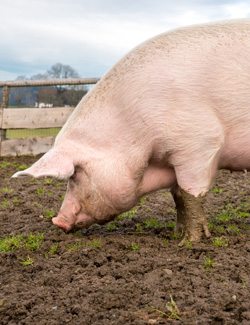 [/column]
[/column]
[column size=”two-third” last=”true”]
13. Ham: 45 IU Vitamin D (11% DV)
You probably didn’t think you were getting Vitamin D while eating ham, but this is just one vitamin that it contains.
Ham is surprisingly high in B Vitamins as well, which will help give you energy throughout the day. Although ham typically gets a bad reputation for being a fatty meat, there are lean cuts of ham and fattier cuts of ham. For most diet plans you’ll want to stick with the leaner cuts, but still it’s not something that you’ll want to overdo.
Go easy on the ham, and don’t rely on it alone to get you to your Vitamin D quota. It’s very high in sodium and also has its fair share of cholesterol, and that’s if you go with lean forms of ham.
Tips for eating more: Go with lean cuts of ham as part of a ham sandwich, or just by itself as the protein portion of a balanced meal.[/column]
[hr]
[column size=”one-third”]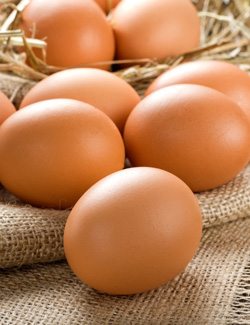 [/column]
[/column]
[column size=”two-third” last=”true”]
14. Eggs: 44 IU Vitamin D (11% DV)
Eggs peep onto our list of foods highest in Vitamin D by the thinnest of margins, but still represent a tenth of what you need in a 100 gram serving. That just shows how high in Vitamin D the other entries on our list are.
The egg debate rages on, and there’s still the question of whether you should eat the entire egg or just go with egg whites. They each have roughly equal amounts of protein, so you’re basically doubling up on the protein when you eat them both together. But egg alternatives and egg white menu options are still quite prevalent.
It’s generally accepted that the yolk contains most of the nutrients in the egg, but also carries with it fat and cholesterol. If you’re trying to lose weight just eat the whites, but if you’re at a healthy weight, eat the whole egg for maximum nutrition.
Tips for eating more: Eggs are so versatile it’s easier to get more of them. You can make an egg salad sandwich by chopping up hard-boiled eggs. Make a batch of hard-boiled eggs and you’ll always have a quick snack option.[/column]
[hr]
[column size=”one-third”] [/column]
[/column]
[column size=”two-third” last=”true”]
15. Salami: 41 IU Vitamin D (10% DV)
Salami slides safely into the last spot on our list with 10% of the Vitamin D you need daily in a 100 gram serving. The only problem is that this same sized serving will get you nearly half of the saturated fat you’re allowed for the day and 72% of the sodium you’re allowed, so you’ll want to keep your serving size to much less than this, meaning you’ll only be getting a bit of Vitamin D.
Salami contains iron, Vitamin B12, calcium, and potassium in addition to Vitamin D, so it’s no one-trick pony when it comes to nutrients.
Because of the fat and sodium content of salami, this is one meat that you’ll want to check your intake of and only use it as a way to spice up a sandwich or flavor up an appetizer.
Tips for eating more: Salami is a somewhat fatty meat, so you wouldn’t want to load up on it just to get more Vitamin D. It can be used as part of your overall effort to eat more Vitamin D foods, not as the one way you’re going to get it done.[/column]



